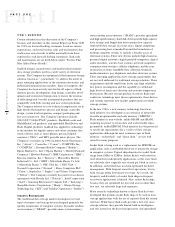SanDisk 1998 Annual Report Download - page 21
Download and view the complete annual report
Please find page 21 of the 1998 SanDisk annual report below. You can navigate through the pages in the report by either clicking on the pages listed below, or by using the keyword search tool below to find specific information within the annual report.
SanDisk Corporation
16
•Increased research and development expenses
• Exchange rate fluctuations
• Changes in general economic conditions, in particular
the economic recession in Japan
When we order silicon wafers from our foundries, we have
to estimate the number of silicon wafers needed to fill product
orders several months into the future. If we overestimate this
number, we build excess inventories which affects our gross
margins and operating results. For example, in the second
quarter of 1998, our product gross margins declined to 12%
from 30% in the previous quarter due in part to a write
down of inventory to reflect inventory at net realizable
value. Because our largest volume product, CompactFlash, is
sold into an emerging consumer market, it is very difficult to
accurately forecast future sales. If sales fall below our forecast,
our operating results could be adversely affected if we are
unable to reduce our operating expenses. More than 50%
of our quarterly sales are from orders received and fulfilled
in the same quarter. In addition, our product order backlog
may fluctuate substantially from quarter to quarter.
Due to anticipated growth, we increased our expense levels
in 1998, including expenses associated with the expansion of
our in-house assembly and test operations. Operating expenses
are expected to continue to increase as a result of the need to
hire additional personnel to support expected growth in
sales unit volumes, marketing and sales efforts and research
and development activities. These expenses cannot be readily
scaled back over the short term. If revenue does not increase
proportionately to operating expenses, or if revenues decrease
or do not meet expectations for a particular period, our
business, financial condition and results of operations will
be adversely affected.
Product mix varies quarterly, which affects our overall average
selling prices and gross margins. Our CompactFlash products,
which currently represent the majority portion of our product
revenues, have lower average selling prices and gross margins
than our higher capacity FlashDisk and FlashDrive products.
We believe that sales of CompactFlash products may become
an even more significant percentage of our product revenues
as consumer applications, such as digital cameras, become
more popular. Dependence on CompactFlash sales, together
with lower pricing caused by competition, has caused average
selling prices to decline substantially over the past year. This
trend is expected to continue. Average selling prices decreased
by 28% in 1998 compared to 1997.
One of our strategies is to cross-license our patents to other
manufacturers of flash products. Under such arrangements,
we earn license fees and royalties on individually negotiated
terms. The timing of revenue recognition from these payments
is dependent on either the terms of each contract or on the
timing of product shipments by the third parties. This causes
license and royalty revenue to fluctuate significantly. Because
this revenue has higher gross margins than product revenue,
gross margins and net income fluctuate more with changes
in license and royalty revenue than with changes in product
revenue.
Our Business Depends Upon Consumer Products
In 1998, we received more product revenue and shipped
more units of products destined for consumer electronics
applications, principally digital cameras, than for any other
applications. We believe that these products will encounter
intense competition and be more price sensitive than products
sold into our other target markets. In addition, we must
spend more on marketing and promotion in consumer markets
to establish brand name recognition and preference.
A significant portion of sales to the consumer electronics
market will be made through distributors and to retailers.
Sales through these channels typically include rights to return
unsold inventory. As a result, revenue is not recognized until
after the product has been sold to the end user. If our retail
customers are not successful in this market, there could be
substantial product returns, which may cause harm to our
business, financial condition and results of operations.
Our Business Depends on Emerging M arkets
and New Products
In order for demand for our products to grow, the
markets for new products that use CompactFlash and the
MultiMediaCard, such as smart phones and MP3 portable
music players, must develop and grow. If sales of these
products do not grow, our product revenues and profit
margins could level off or decline. To remain competitive,
we intend to develop new products with increased memory
capacity at a lower cost per megabyte. The success of this
new product strategy will depend upon, among other things,
the following:
• Our ability to successfully develop new products with
higher memory capacities at a lower cost per megabyte;
• The development of new applications or markets for
our flash data storage products;
• The extent to which prospective customers design our
products into their products and successfully introduce
their products;
• The extent to which our products or technologies
become obsolete or noncompetitive due to products or
technologies developed by others.
If our new applications or target markets fail to develop, or
if our products are not accepted by the market, our business,
financial condition and results of operations could suffer.
There Is Seasonality In Our Business
The sales of our products, in particular the sale of CompactFlash
Products, in the consumer electronics applications market
are subject to seasonality. As a result, product sales are
impacted by seasonal purchasing patterns with higher sales
in the second half of each year as compared to the first half
of each such year. In addition, we historically experience a
























